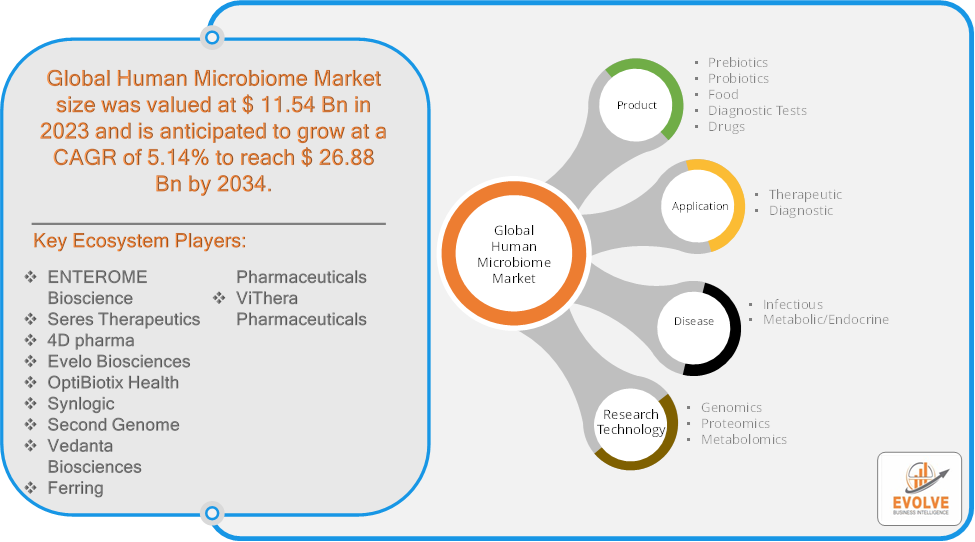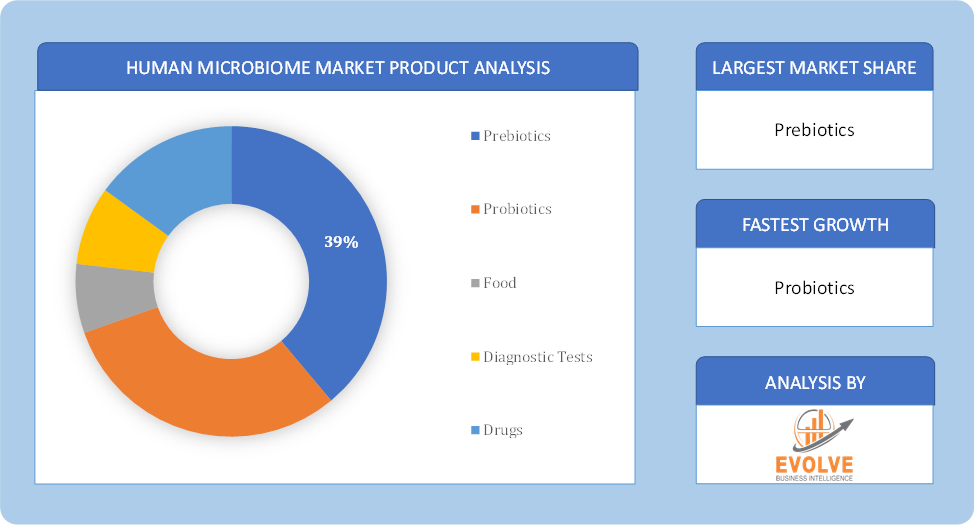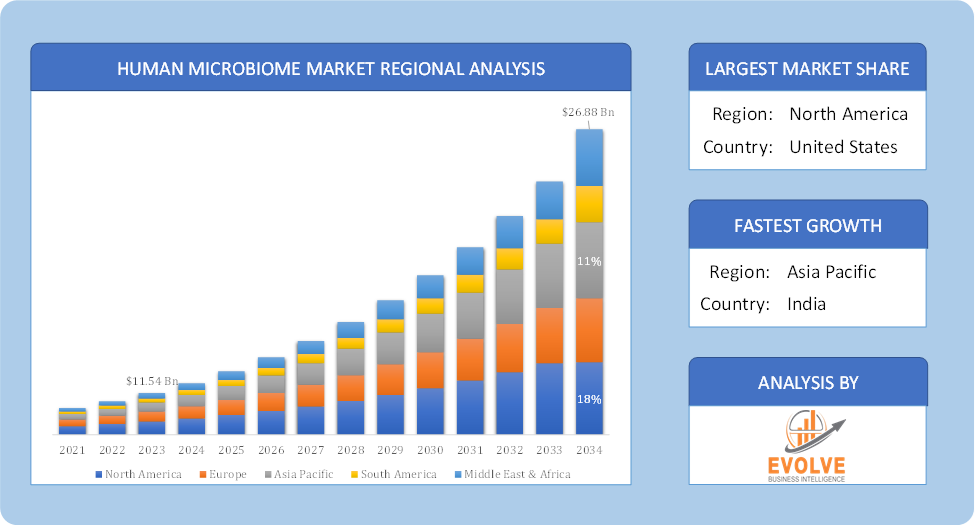Human Microbiome Market Analysis Overview
The Human Microbiome Market Analysis size accounted for USD 11.54 Billion in 2023 and is estimated to account for 12.77 Billion in 2024. The Market is expected to reach USD 26.88 Billion by 2034 growing at a compound annual growth rate (CAGR) of 5.14% from 2024 to 2034. The Human Microbiome Market Analysis refers to the evaluation and assessment of the market related to the human microbiome, which is the collective community of microorganisms (including bacteria, viruses, fungi, and protozoa) that inhabit various parts of the human body, primarily the gut.
This analysis is crucial for stakeholders, including businesses, investors, healthcare providers, and researchers, to understand the landscape of the human microbiome market and make informed decisions. The human microbiome market analysis provides valuable insights into the commercial potential of this emerging field.
Global Human Microbiome Market Analysis Synopsis
 Human Microbiome Market Analysis Dynamics
Human Microbiome Market Analysis Dynamics
The major factors that have impacted the growth of Human Microbiome Market Analysis are as follows:
Drivers:
Ø Advancements in Research and Technology
Innovations in genomics, proteomics, and bioinformatics have enabled better understanding and analysis of the human microbiome, leading to the development of novel microbiome-based therapies and diagnostic tools. The shift toward personalized medicine is fueling interest in microbiome profiling and tailored interventions based on individual microbiome compositions, driving investment and research in the sector. Increased integration of microbiome research in clinical settings and healthcare practices is enhancing the understanding of its impact on various health conditions, leading to new treatment options and approaches.
Restraint:
- Perception of Scientific Uncertainty and Data Privacy Concerns
The complexity of the human microbiome and its interactions with host physiology remain poorly understood. This scientific uncertainty can impede the development of effective therapies and diagnostic tools. The collection and analysis of microbiome data raise privacy and ethical concerns. Potential customers may hesitate to share personal data, affecting the development of personalized microbiome products.
Opportunity:
⮚ Personalized Nutrition and Medicine
The trend toward personalized medicine offers opportunities for developing customized probiotics, prebiotics, and dietary recommendations based on individual microbiome profiles, catering to specific health needs. Increased consumer interest in functional foods that promote gut health creates opportunities for the development and marketing of microbiome-friendly food products, including fermented foods, dietary supplements, and fortified foods. The rise of digital health technologies, such as mobile health apps and telemedicine, provides opportunities for tracking and analyzing microbiome health, creating platforms for personalized microbiome interventions.
Human Microbiome Market Analysis Segment Overview
Based on Product, the market is segmented based on Prebiotics, Probiotics, Food, Diagnostic Tests and Drugs. The drug segment dominant the market. The human microbiota, a collective term for the billions of microorganisms that cover human tissues, contains bacteria, fungi, and viruses. The term “microbiome” refers to all of these microorganisms’ genes. The most significant product section belonged to the drugs category. This segment’s considerable market share may be due to an increase in medicinal treatments based on the human microbiome that are now undergoing clinical trials and increasing funding for their development.
By Application
Based on Application, the market segment has been divided into Therapeutic and Diagnostic. The therapeutics segment dominant the market. The increase in R&D investment for microbiome-based medicines worldwide is a significant factor driving the growth of this application area. Furthermore, technological developments, increased clinical trials for the diagnostics segment, and increased partnerships between leading market players and research institutes are all contributing to market expansion.
By Disease
Based on Disease, the market segment has been divided into Infectious and Metabolic/Endocrine. The infectious illness segment dominant the market. The growing awareness of the negative consequences of antibiotic usage on natural flora (such as disruptions) has underlined the necessity for bacterial-targeted treatment for infectious disorders. The increased prevalence of illnesses caused by microbial dysbiosis as a result of antibiotic therapy and the increasing number of clinical studies for the development of target-specific microbiome-based therapeutics are the primary reasons driving the expansion of this segment.
By Research Technology
Based on Research Technology, the market segment has been divided into Genomics, Proteomics and Metabolomics. The Metabolomics segment dominant the market. Metabolomics is the comprehensive analysis of metabolites, which include various small molecules such as amino acids, fatty acids, carbohydrates, and other metabolites that are present in biological samples. In the context of the human microbiome, it involves studying the metabolites produced by gut microbiota and their effects on human health.
Global Human Microbiome Market Analysis Regional Analysis
Based on region, the global Human Microbiome Market Analysis has been divided into North America, Europe, Asia-Pacific, the Middle East & Africa, and Latin America. North America is projected to dominate the use of the Human Microbiome Market Analysis followed by the Asia-Pacific and Europe regions.
 Global Human Microbiome North America Market
Global Human Microbiome North America Market
North America holds a dominant position in the Human Microbiome Market Analysis. North America is currently the largest market for human microbiome products and services, driven by robust research and development activities, a well-established healthcare system, and a high level of consumer awareness. And A focus on personalized medicine, the development of microbiome-based therapeutics, and the integration of microbiome data into electronic health records.
Global Human Microbiome Asia-Pacific Market
The Asia-Pacific region has indeed emerged as the fastest-growing market for the Human Microbiome Market Analysis industry. The Asia-Pacific region is a rapidly emerging market for human microbiome products, driven by a growing middle class, increasing healthcare spending, and a rising awareness of the benefits of microbiome-based interventions and A focus on traditional medicine and herbal remedies, the development of affordable microbiome-based solutions, and the integration of microbiome data into digital health platforms.
Competitive Landscape
The global Human Microbiome Market Analysis is highly competitive, with numerous players offering a wide range of software solutions. The competitive landscape is characterized by the presence of established companies, as well as emerging startups and niche players. To increase their market position and attract a wide consumer base, the businesses are employing various strategies, such as product launches, and strategic alliances.
Prominent Players:
- ENTEROME Bioscience
- Seres Therapeutics
- 4D pharma
- Evelo Biosciences
- OptiBiotix Health
- Synlogic
- Second Genome
- Vedanta Biosciences
- Ferring Pharmaceuticals
- ViThera Pharmaceuticals
Key Development
In Sept 2022, The FDA’s Vaccines and Related Biological Products Advisory Committee approved Ferring Pharmaceuticals’ RBX2660 for use in its investigational microbiota-based live biotherapeutic trial for its ability to lower the C. difficile infection (CDI) recurrence after antibiotic therapy.
Scope of the Report
Global Human Microbiome Market Analysis, by Product
- Prebiotics
- Probiotics
- Food
- Diagnostic Tests
- Drugs
Global Human Microbiome Market Analysis, by Application
- Therapeutic
- Diagnostic
Global Human Microbiome Market Analysis, by Disease
- Infectious
- Metabolic/Endocrine
Global Human Microbiome Market Analysis, by Research Technology
- Genomics
- Proteomics
- Metabolomics
Global Human Microbiome Market Analysis, by Region
- North America
- US
- Canada
- Mexico
- Europe
- UK
- Germany
- France
- Italy
- Spain
- Benelux
- Nordic
- Rest of Europe
- Asia Pacific
- China
- Japan
- South Korea
- Indonesia
- Austalia
- Malaysia
- India
- Rest of Asia Pacific
- South America
- Brazil
- Argentina
- Rest of South America
- Middle East & Africa
- Saudi Arabia
- UAE
- Egypt
- South Africa
- Rest of Middle East & Africa
| Parameters | Indicators |
|---|---|
| Market Size | 2034: USD 26.88 Billion |
| CAGR (2024-2034) | 5.14% |
| Base year | 2022 |
| Forecast Period | 2024-2034 |
| Historical Data | 2021 (2017 to 2020 On Demand) |
| Report Coverage | Revenue Forecast, Competitive Landscape, Growth Factors, and Trends |
| Key Segmentations | Type, Application, Disease, Research Technology |
| Geographies Covered | North America, Europe, Asia-Pacific, South America, Middle East, Africa |
| Key Vendors | ENTEROME Bioscience, Seres Therapeutics, 4D pharma, Evelo Biosciences, OptiBiotix Health, Synlogic, Second Genome, Vedanta Biosciences, Ferring Pharmaceuticals and ViThera Pharmaceuticals. |
| Key Market Opportunities | · Personalized Nutrition and Medicine · Integration with Digital Health |
| Key Market Drivers | · Advancements in Research and Technology · Integration of Microbiome Research in Healthcare |
REPORT CONTENT BRIEF:
- High-level analysis of the current and future Human Microbiome Market Analysis trends and opportunities
- Detailed analysis of current market drivers, restraining factors, and opportunities in the future
- Human Microbiome Market Analysis historical market size for the year 2021, and forecast from 2023 to 2033
- Human Microbiome Market Analysis share analysis at each product level
- Competitor analysis with detailed insight into its product segment, Government & Defense strength, and strategies adopted.
- Identifies key strategies adopted including product launches and developments, mergers and acquisitions, joint ventures, collaborations, and partnerships as well as funding taken and investment done, among others.
- To identify and understand the various factors involved in the global Human Microbiome Market Analysis affected by the pandemic
- To provide a detailed insight into the major companies operating in the market. The profiling will include the Government & Defense health of the company’s past 2-3 years with segmental and regional revenue breakup, product offering, recent developments, SWOT analysis, and key strategies.







